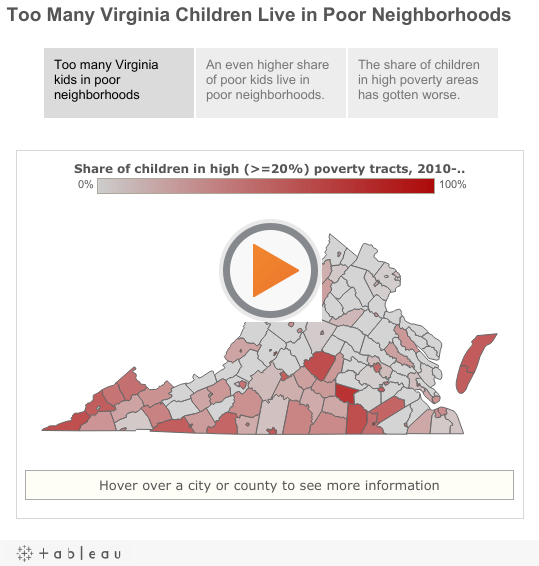January 14, 2016
Poor Virginia Children are Increasingly Isolated in their Communities
What’s even worse, though, is if you are poor and live in a neighborhood where a lot of other people are poor too. In areas with a high concentration of poor people–above 20 percent–it becomes far harder to make it to the middle class, because poor neighborhoods often have struggling schools, serious health challenges, and few job opportunities. And above that 20 percent threshold, outcomes for kids keep getting worse as poverty becomes more concentrated, with the largest negative impacts in areas where more than 40 percent of residents are poor.
Notably, having some low-income people in an area does not lead to negative outcomes. It’s only when the poverty is concentrated that we see challenges emerge. So if all of our neighborhoods had a reasonable mix of household incomes, we would not have to have neighborhoods with bad outcomes for children.
Unfortunately, children in Virginia are more likely now than in past years to live in neighborhoods with very high concentrations of poverty, according to new census data.
Over 23,000 poor Virginia children live in very high poverty areas where more than 40 percent of their neighbors are poor, according to newly released 2010-2014 American Community Survey data. That means 1 out of every 12 poor children is stuck in a neighborhood that makes it harder for them to succeed in life.
When children grow up in an area with a high concentration of poverty, they are less likely to have access to a decent education, a safe environment to play outdoors, and adult mentors who can connect them to job opportunities. In other words, all the things that promote healthy growth and opportunity aren’t there.
Data on the number of children who live in areas with relatively high, but not extreme, concentrations of poverty is even more striking. Over 118,000 poor Virginia kids live in areas where more than 20 percent of their neighbors are poor. That’s more than 4 in every 10 poor children.
This is bad, and it’s worse than in the past. Virginia has seen a 27 percent jump in the share of poor Virginia children who live in neighborhoods with concentrations of poverty above 40 percent since the 2005-2009 period. That means that poor children are now more likely than in the past to live in very poor neighborhoods.
You can explore the data using TCI’s new interactive graphic below on the concentration of poverty in Virginia by city and county. (NOTE: The map has three tabs.)

Most neighborhoods in Virginia have poverty rates under 10 percent, and just 3 percent of neighborhoods have high concentrations of poverty. And overall, just 2 percent of Virginia’s population lives in these high poverty neighborhoods.
Still, the fact that 8 percent of Virginia’s poor children are in these very high poverty areas means that many of Virginia’s children can’t get the opportunities they need to thrive and reach their full potential. That’s a tragedy for them, and a lost opportunity for all of us.
